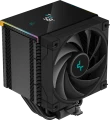Add to comparison |  |  |
|---|---|---|
| Deepcool AK500S Digital White | Deepcool AK500 Digital Black | |
from £48.00 | Compare prices 1 | |
| TOP sellers | ||
A display built into the top panel, which can display various information about the state of the computer, such as temperature and processor load. Connects via USB 2.0. Management is carried out through the Deepcool Digital application. | A display built into the top panel, which can display various information about the state of the computer, such as temperature and processor load. Connects via USB 2.0. Management is carried out through the Deepcool Digital application. | |
Main specs | ||
| Features | for CPU | for CPU |
| Product type | air cooler | air cooler |
| Air flow direction | sideways (dispersion) | sideways (dispersion) |
Fan | ||
| Number of fans | 1 | 1 |
| Fan size | 120 mm | 120 mm |
| Fan thickness | 25 mm | 25 mm |
| Bearing | hydrodynamic | hydrodynamic |
| Min. RPM | 500 rpm | 500 rpm |
| Max. RPM | 1850 rpm | 1850 rpm |
| Speed controller | auto (PWM) | auto (PWM) |
| Max. air flow | 68.99 CFM | 68.99 CFM |
| Static pressure | 2.19 mm H2O | 2.19 mm H2O |
| replaceable | ||
| Noise level | 28 dB | 28 dB |
| Power source | 4-pin | 4-pin |
Radiator | ||
| Heat pipes | 5 | 5 |
| Heatpipe contact | indirect | indirect |
| Heatsink material | aluminium / copper | aluminium / copper |
| Plate material | aluminium | nickel-plated copper |
| Socket | AMD AM4 AMD AM5 Intel 1150 Intel 1155/1156 Intel 2011 / 2011 v3 Intel 2066 Intel 1151 / 1151 v2 Intel 1200 Intel 1700 / 1851 | AMD AM4 AMD AM5 Intel 1150 Intel 1155/1156 Intel 2011 / 2011 v3 Intel 2066 Intel 1151 / 1151 v2 Intel 1200 Intel 1700 / 1851 |
General | ||
| Display | ||
| Lighting | ||
| Lighting colour | ARGB | ARGB |
| Lighting sync | multi compatibility | multi compatibility |
| Mount type | bilateral (backplate) | bilateral (backplate) |
| Dimensions | 125x96x160 mm | 127x117x160 mm |
| Height | 160 mm | 160 mm |
| Weight | 904 g | 1291 g |
| Added to E-Catalog | april 2024 | december 2023 |